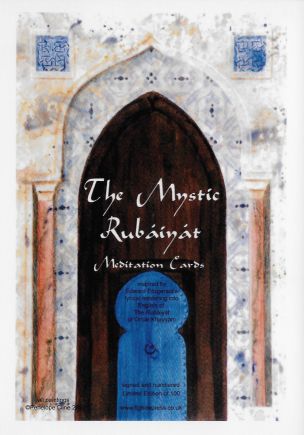The Mysticism of the Ruba’iyat of Omar Khayyam. A.N.J. Whymant
In: Islamic Review and Arab Affairs, Vol. 3 (1915), 10, pp. 540–546
Archives
The Psychology of the Persian (Mystic) Philosophers
The Psychology of the Persian (Mystic) Philosophers. No. 1. Omar Khayyám. A.N.J. Whymant
In: Islamic Review and Arab Affairs, Vol. 3 (1915), 7, pp. 346-350
The mystic Rubáiyát
The mystic Rubáiyát. [Translated by Edward FitzGerald. Illustrated by Penelope Cline]. Fig Tree Press, 2016. – 75 illustrations in colour; 17 x 11 cm.
75 quatrains. – 100 numbered sets of tarot playing cards.
Pessoa, Borges and Khayyam
Pessoa, Borges and Khayyam. Fabrizio Boscaglia
Variaciones Borges, 2015, nr. 40, pp. 41–64.
The fascinating possibility of an encounter between Pessoa and Borges in Lisbon, in May 1924, at the end of Borges’s second trip in Europe, has been the departing point for some comparative readings on these authors (Rodriguez Monegal 15-16; Ferrari and Pizarro 91; Balderston 168). The author wants to imagine that, if it had happened, they would have discussed, among other things, a work which both would later mention in their upcoming publications and that would become an important reference to both of them. It is the Rubaiyat of the Persian poet and philosopher Omar Khayyam (1048-1131), in the famous English translation by the English poet Edward FitzGerald (1809-1883), first published in 1859.
Veiling the Mystic in the Hedonist’s Gear: A Comparative Rereading of Omar Khayyam’s The Rubaiyat …
Veiling the Mystic in the Hedonist’s Gear: A Comparative Rereading of Omar Khayyam’s The Rubaiyat and Harivansh Rai Bachchan’s Madhuśālā. Prasun Banerjee.
The Contour, 1 (2015) 4 (April), pp. 14-21.
Despite the conspicuous mystic perspectives, the recognition of the Rubaiyat to the Western literary discourse has essentially been as a hedonist poem celebrating the paganistic wine-intoxicated revelry and joys of earthly life and that of Omar Khayyam as the poet of the sharab (wine), saki (wine-girl) and peyala(wine-pot). But a careful scrutiny of the Persian and oriental tradition of poetry would reveal that the Rubaiyat is fraught with poetic devices that indicate at established Sufistic discourses in Khayyam’s verses, almost akin to the poets like Rumi, Hafeez or Ferdowsi.
Implications of Mystic Intoxication in Chinese and Iranian Poetry
Implications of Mystic Intoxication in Chinese and Iranian Poetry. R. Weston.
The Undergraduate Historical Journey, 1 (2014) 1, pp. 5-9.
In analyzing the works of Chinese Tang poet Li Bo (701-762),1 one notices the reoccurring reference to “drunkenness” or drinking of wine; though it can be taken at face value to represent a state of being in the literal sense—that is, what appears to be an intoxicated stupor—it seems more practical to consider a more figurative meaning. Namely, it is possible to interpret themes of wine and drunkenness as allegories for spiritual enlightenment, be it found in nature or simply life in general.
Omar Khayyám (1040/62 -1131/32) y la filosofía árabe
Omar Khayyám (1040/62 -1131/32) y la filosofía árabe. Martín González Fernández.
Revista Española de Filosofía Medieval, 21 (2014), pp. 119-130.
This article analyzes the figure of Omar Khayyam (Nîsâbur, Persia, ca. 1040/62, – ca. 1131/32, Nîsâbur) by looking at his famous quatrains or rubayat, focusing on the reception and review of the Arab philosophies of his time, and the defense that he makes of Persian Archaic, Zoroastrian, Mazdean and Manichean culture and philosophy.
